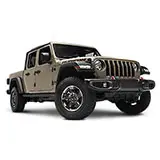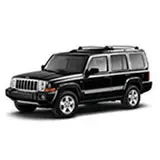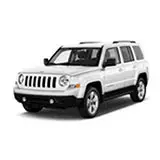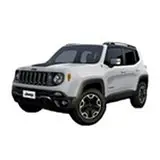The Jeep Wrangler through the Years
In the 1940s, the term “jeep” referred to the mighty and agile 4x4s of the Second World War. At present, the name means the brand behind the off-road king Wranglers. Jeep has had a good run in its colorful history within this time frame. Ownership jumped from under one name to another, marking the end of an era and the start of a new one with each turnover.
Jeep is legendary. No question. Its rich history and how it remains a parcel of someone’s dear memory speaks volumes about its brand and reputation. One of our friends on Yittzy shared a historic photo of their father driving one of the first Jeeps of the US Air Force during the war:
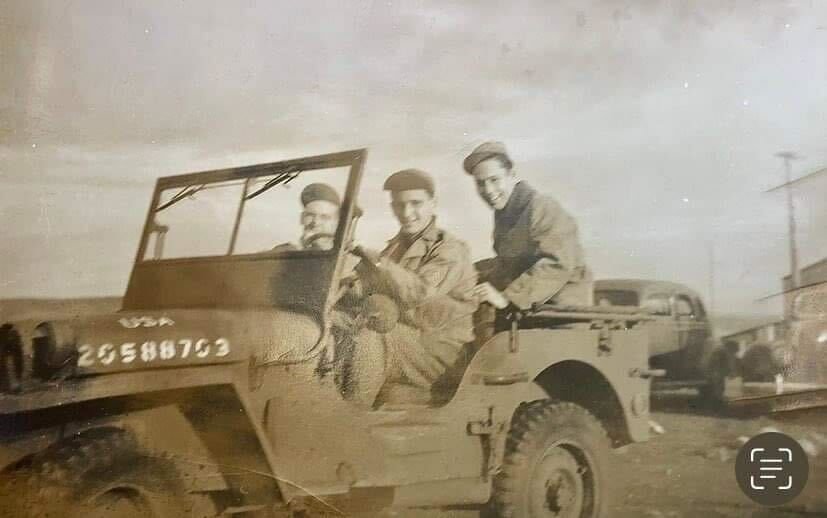
…my Dads name was Edward H Reed, he was a Seargent in the Army Air Corp at Ephrata Army Air Corp base in Washington state. My Dad driving one of the first Jeeps at the Air Force base in Washington St.. This was where they trained a lot of pilots. One of my Dads jobs he’d never told me about just before he passed. There were quite a few deaths as many planes crashed. It was Dads job to gather up the soldiers belongings, and contact the family and send back their belongings. My Dad never saw combat as when they were getting on the train to go overseas, the train jerked, my Dad fell and injured his back bad. He always said that happened as he always carried a lucky penny my Mom gave him.



Jeep CJ: the Wrangler’s ancestor
Even before the complete victory of the Allied forces in 1945, the jeeps that GIs used were already set for a makeover. Willys-Overland, the manufacturer of the Willys MB saw that time as the perfect signal for the transition of the MB into civilian use. Civilian jeeps, they were called; hence the name CJ.
The CJ retained the same rugged look of wartime MBs. After all, it had the same frame and only changed a few things. Willys added a tailgate to fit more stuff. CJ had bigger headlights and a canvas roof. Besides these modifications, the CJ sported the same performance as the MB. And unfortunately, the same roughness.
The CJ2A was marketed as a utilitarian vehicle, but this brand positioning didn’t spare the carmaker from the demands of consumers for a comfortable ride. In response, Willys released the CJ3A. It had better legroom, more comfortable seats, and offered a better driving experience than the first two. However, this still didn’t make the sales pump. Next in the experiment queue was the CJ3B with a bigger engine, more power, and a bulkier look.
Coinciding with the release of the CJ3B, Kaiser Motors bought Willys Overland. From 1953 onwards, Jeep was under new ownership–Willys Kaiser.


A complete turn of events was ushered in by the iconic CJ5 from 1955. It was THE JEEP. The civilian market finally got a Jeep that offered superb power and versatility between work and play. It was followed by the CJ6, a slightly longer Jeep than its predecessor.
While it was the norm for the automaker to halt production of the last Jeep model once a new CJ hits the showroom, it wasn’t the case for CJ3B. It remained in production for several years after CJ5 and CJ6 were released.
You might ask, what about the CJ4? Why skip to 5? Well, there was a CJ4, but it never saw the outside of the Jeep factory. Only one prototype was made, and it was a cross between the previous CJ3B and the incoming CJ5. It was reportedly sold to an employee.

The CJ5 and CJ6 were marketed as sports versions of the civilian Jeep, which was a massive hit. CJ5 retained the dimension of the previous models while CJ6 had a slightly longer wheelbase. Both were redesigned with a curvier bodywork.
From the release of the first CJ5 and CJ6, it took Willys Kaiser ten years to take a bold leap and change the engine for the new offerings of the CJ5 and CJ6. The standard Hurricane engine the CJs came with remained one of the choices. Joining it in 1961 was the 3.15L 4-cylinder Perkins 192 cu. in. diesel engine that put out 62 hp. And in 1965, they added the 3.7L 225 cu.in. Dauntless V6 engine that put out a whopping 155 hp.
Then came 1970, and another change in ownership was due. The owner of the CJs was the American Motors Corporation (AMC). The first order of business was to stop using engines manufactured by others since AMC was capable of making its own. AMC had a complete change of branding from the agricultural workhorse that the CJ was known to be into a sports vehicle.
Starting 1972, the Hurricane engine bade its last farewell, replaced by the AMC “Torque Command” 3.8L 6-cylinder engine. The bigger 4.2L engine made by AMC became the standard option for the new generation of CJs. Of course, a V8 was an option for those who needed speed in their new trendy and sporty CJ.
To fit these bulkier engines in the good, the AMC redesigned the body of the CJ. The box-frame chassis now had six riveted cross members, and the wheelbase got two extra inches.
It was a series of massive upgrades from then on. In 1973, AMC the Quadra-Trac four-wheel drive system. Together with the high- and low-range gears, the Quadra-Trac system allowed for a center lockable differential feature. Another notable upgrade during this time was the Cold Climate Package which came with an engine block heater for better offroading in the freezing wild.
AMC peppered the market with many special editions for the CJ5 and CJ6. In 1961, there was the Tuxedo Park, Camper in 1969, Renegade in 1971, Super Jeep in 1973, Golden Eagle in 1977, the 1979 Silver Anniversary Edition, Golden Hawk in 1980, and finally, the Laredo produced until 1983.

The CJ of the 70s had two AMC inline-six engines and a 304-cubic-inch V8. This new engine was accompanied by a new design (an additional 10 inches) and a Quadra-Trac four-wheel-drive system that was introduced during the reign of the CJ5 and CJ6. It sounds like a massive upgrade because it was. It translated to sales; long story short, the CJ7 was a hit. It had multiple trim levels: Laredo, Renegade, Golden Hawk, Golden Eagle, and the top-of-the-line Jamboree.
From sports to comfort, the CJ7 was designed to conquer any road and curb the market’s thirst for a vehicle that offered both adventure and comfort. Equipped with the Quadra-Trac for the low range of the bumpy mountains to the high range needed for highway speed. And the added comfort of more space behind the rear passenger seat was an iconic feature of the CJ7.
Between the CJ2A and the CJ7, it was a 41-year run. Ending this ear was a turnover of the Jeep brand to Chrysler. The first model under this new home was the YJ, more popularly known as the first Wrangler.
Besides this, an incident forced Jeep to swap the Jeep CJ with a more reliable Jeep. A segment on the program 60 Minutes showed a CJ rolling over when it made a J-turn. People were naturally alarmed, and CJ’s reputation was damaged. The CJ was known to be the Jeep that had the tendency to roll over.
Alarmed citizens and activists alike clamored for investigation over the supposed design flaw of the CJ; however, these were rejected by the National Highway Traffic Safety Administration, citing a lack of cause for further investigation. It was revealed a little later that the program blew the numbers out of proportion; out of the 435 trials made on the CJ, there were only 8 rollovers, 4 of which came from the same unit. It was too late to patch things up, so the company had to do good with the newly released Wrangler.
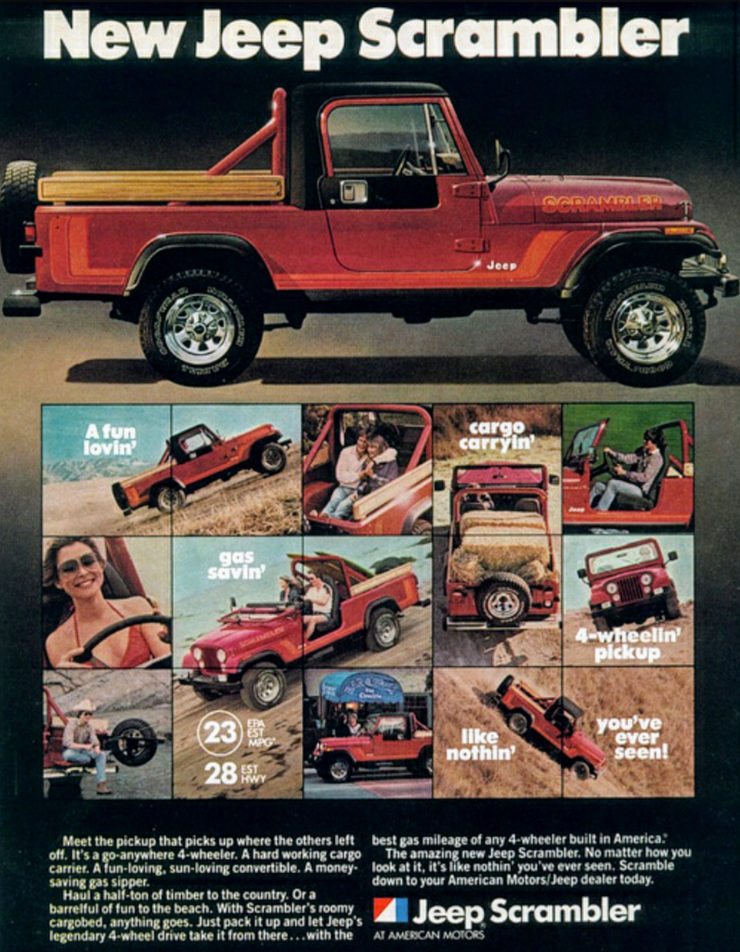
But before the Wrangler came into view, a ten-year-old CJ was released in 1981. The vision and planning for the Jeep Scrambler CJ8 were started by AMC before the CJ5 and CJ6 upgrades. But it was only released in 1981, five years after the CJ7.
Scrambler was a sport-utility vehicle that mixed the CJ7’s long wheelbase and the frame of a pickup truck. It was famous as President Ronald Reagan’s Jeep.
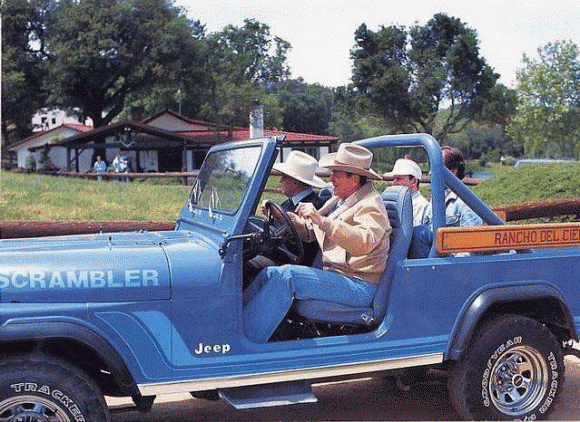
Scrambler was Jeep’s first converticble compact truck. However, it was a bit late to the game. Around that time, Chrysler, Chevrolet, and Ford were already faring well against Japanese carmakers in the compact truck department. Still, being America’s first compact truck made the playing field less harsh for AMC.
The Scrambler came with two engine options: an AMC 4.2-L/258 cu. in. I6-2V OHV engine or a 2.5-L/150 cu. in. I4-1V OHV engine. Paired with either was a4-speed manual transmission. Other powertrain options were a 3-speed automatic and a T-5 transmission with an overdrive option.
The C8 ended the CJ line that ran for more than four decades.
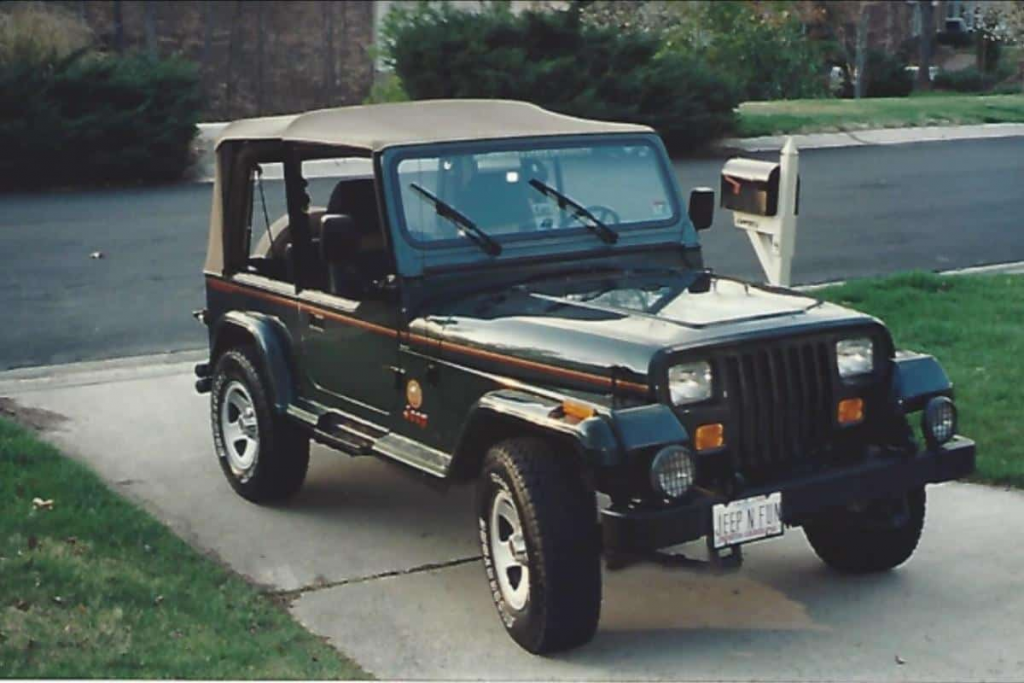
The following 4 Wrangler generations
Following the rollover fiasco, Jeep made sure to ease consumers’ worry over safety. Introduced in 1987, the first release of the Wrangler YJ sported anti-roll bars. It had the same frame as the CJ, but the new rectangular headlights were a fresh look (although reportedly, some Jeep fans were not exactly pleased). It also borrowed Cherokee’s interior and suspension.
The same rugged and rough appeal of the CJ remained with the Wrangler, but Jeep had to step up its comfort game to appeal to a broader consumer base. After all, the Jeep was slowly turning into a daily drive other than a weekend offroader at this point.
YJ was lower to the ground than the CJ but had the same 93.4-inch wheelbase. Its hood housed a 2.5L inline-four engine but could be upgraded to a 4.2L six-cylinder engine. In 1991, a further upgrade was made available to Jeep fans through a fuel-injected 4.0L engine, putting out an extra 75 horsepower. Then in 1994, an automatic transmission YJ was made available to the public.
Basically, the YJ was a CJ with upgraded drivability and safety, and well, square headlights.
What trim levels did the YJ have?

Wrangler TJ (1996-2006)
The first ever Wrangler TJ rolled out in 1997. And guess who made a comeback? The round headlights of the CJ!! Learning from its previous rights and wrongs, Jeep did well with the TJ, making it a crowd favorite among Jeep enthusiasts. Many fans even hailed it as the Jeep’s favorite child.
It had the same roughness and ruggedness, but an improvement in the suspension department was the switch to coils springs, paving the way to smoother Wrangler rides. With a stiffer frame and body but the same engine choices as the YJ, the TJ was pretty much a makeover of its older brother.
TJ had improved off-road capabilities and more advanced technologies, which was natural since they belonged to different generations. The TJ had higher ground clearance than the YJ, giving drivers more confidence in the dirt road. It was also during this time that Jeep dropped AMC engines from its manufacturing lines. The TJ was the first Wrangler to have airbags. And, of course, the TJ had the first Rubicon trim level.
What was so special about the Wrangler Rubicon?
Wrangler is an off-roading vehicle, but out of all the Wranglers, the Rubicon is the best off-roader. That’s what made this particular Wrangler so special. It had front and rear Dana 44 axles, an upgraded six-speed manual transmission, diamond plate rocker panels, higher fender flares, and a standard 4.0L i-6 engine.
The Wrangler TJ Rubicon was available from 2003 to 2005 and hit the sales pedal so hard it was the hottest selling Jeep ever.
What trim levels did the TJ have?
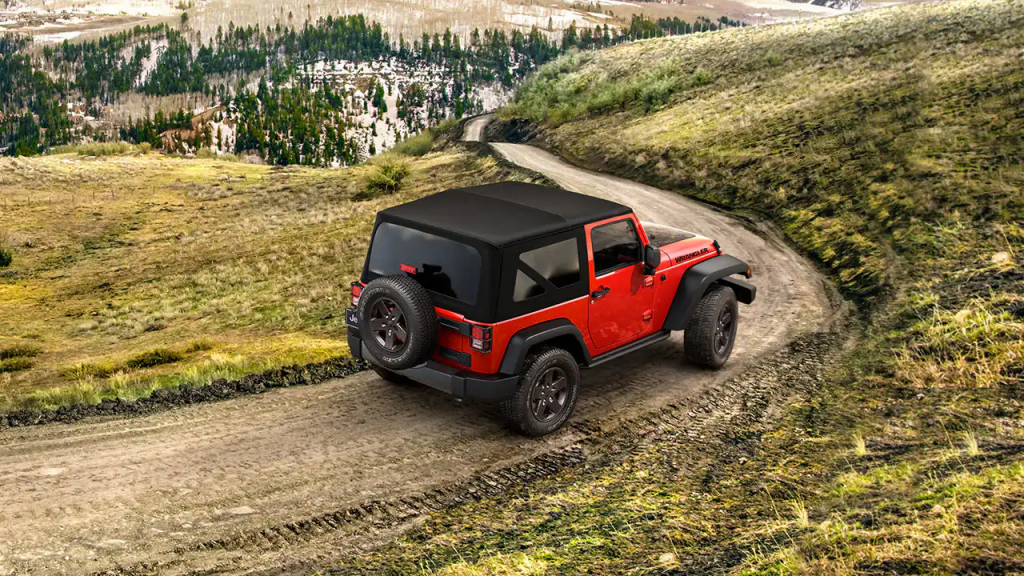
Wrangler JK (2006-2018)
How do you know which Wrangler is a JK? If it has four doors, you got it. Well, the latest generation Wrangler has them, too, but from the beginning of Jeep history until 2018, the JK was the only Wrangler with four doors. More people to bring on an offroad trail means more fun!
The JL is wider by 5 inches than the TJ. That is an added wiggle room. Some complained that it might make the tighter trails more challenging to get through, but 2.5 inches added on each side won’t make trains that difficult. Folding your side mirrors in would usually do the trick.
A massive plus of the JK is for fans of modification and upgrades. Significantly lowering the base price of the JK was using less expensive components for parts that were usually upgraded anyway. Factory bumpers aren’t popular among Jeep users, so using plastic was a good call.
The first JKs until 2011 had the 3.8L EGH V6 paired with either a 4-speed 42RLE automatic or 6-speed NSG370 manual transmission. Then in 2012, Jeep switched the engine out to the 3.6L Pentastar V6. It had the same 6-speed NSG370 for the manual transmission option and the 5-speed W5A580 for the automatic transmission option.
Customization is a big plus for the JK. Among the trim levels, added options were removable doors, soft or hard covers, power windows, and other accessories.
What trim levels did the JK have?
Sport
Sport-S
Sahara
Rubicon
Black Bear
How do you know which Wrangler is a JK? If it has four doors, you got it. Well, the latest generation Wrangler has them, too, but from the beginning of Jeep history until 2018, the JK was the only Wrangler with four doors. More people to bring on an offroad trail means more fun!
The JL is wider by 5 inches than the TJ. That is an added wiggle room. Some complained that it might make the tighter trails more challenging to get through, but 2.5 inches added on each side won’t make trains that difficult. Folding your side mirrors in would usually do the trick.
A massive plus of the JK is for fans of modification and upgrades. Significantly lowering the base price of the JK was using less expensive components for parts that were usually upgraded anyway. Factory bumpers aren’t popular among Jeep users, so using plastic was a good call.
The first JKs until 2011 had the 3.8L EGH V6 paired with either a 4-speed 42RLE automatic or 6-speed NSG370 manual transmission. Then in 2012, Jeep switched the engine out to the 3.6L Pentastar V6. It had the same 6-speed NSG370 for the manual transmission option and the 5-speed W5A580 for the automatic transmission option.
Customization is a big plus for the JK. Among the trim levels, added options were removable doors, soft or hard covers, power windows, and other accessories.
What trim levels did the JK have?
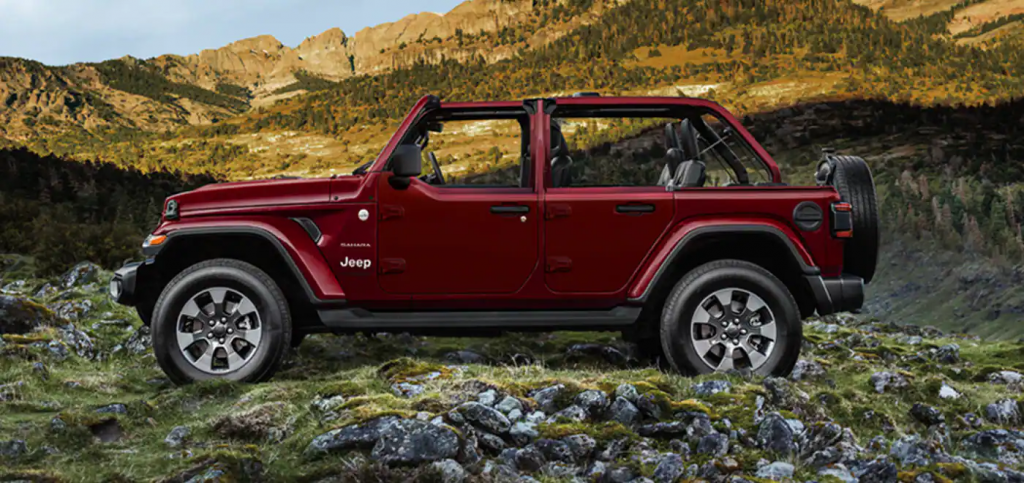
Wrangler JL (2018-Today)
And today, we have the Wrangler JL. It’s obviously the smartest Jeep generation offered in three different four-wheel drive technologies: Command-Trac, Selec-Trac, and Rock-Trac. Its driver assist and infotainment system are superb, too. It has Bluetooth compatibility for the modern-day driver, parking sensors, and blindspot monitoring.
It’s lighter than the JK, but is slightly longer. Its front windshield can be folded or removed. The doors and the roof can be quickly taken off, too.
The 3.6 L Pentastar VVT V6 gasoline engine is still here, although it now has improved fuel economy. A six-speed manual is still an option, but the latest transmission options include an eight-speed automatic.
What trim levels did the JL have?
For almost 80 years, the Wrangler and its predecessor have gone from being a military vehicle to a weekend offroader to a daily driver with both on-road and off-road might. It was quite a journey of trial and error; and a long one at that.

